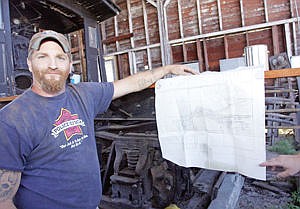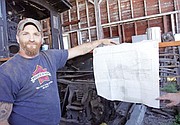Heritage Museum raises $30,000 for locomotive
The Heritage Museum will keep chugging along in its quest to refurbish the Shay locomotive that rests in a shed on the museum grounds.
"We saw it sitting there behind the cage, and it was literally falling apart," said Ron Carter, a volunteer on the project. "It was just disgraceful. We wanted to do something more than just slap a new coat of paint on it like they’ve done in the past."
Since that decision over three years ago, the museum has raised over $30,000 in private donations to refurbish the train and get it running again. However, they still have a long way to go before they can complete the project.
"We need at least 50 [thousand] more for this phase of the project," said Ron Carter. "And after that, we’ll need around $300,000 for the full thing."
Carter is one of several volunteers who has worked tirelessly over the past three years to begin restoring the locomotive. The end goal is to create a seven or eight mile track that runs up to the mine site outside Libby and over Kootenai River, along the track and bridge that was originally laid in the early 1900s for this specific train. The train will pull tourists and locals alike, showing them the sights and giving an exceptionally realistic tour.
"They’ll get a real good look around," Carter laughed. "Since this particular locomotive only runs about 12 miles per hour."
Right now, the crew is working on the first phase, which restore the engine and lay about a mile of track around the museum’s grounds.
The locomotive, which is fondly known as "Ole Four Spot" is located in front of the Heritage Museum, where its been on display for the past few decades. It was built in 1906 by the Lima Locomotive Works in Lima, Ohio.
"It’s a pretty rare item," Carter said. "There were six others in the fleet, and all the others have been scrapped."
The train was purchased by the Libby Lumber Co. in 1909, who dubbed her "Libby Lumber Engine No 4." She has retained the number four through all ownership since, which gives the name Ole Four Spot.
Most of her work was hauling logs, supplies and logging crews over the steep logging lines east of Libby, with a range of only 15 miles.
In 1936, railway logging gave way to truck logging, so Ole Four Spot was used to switch cars in the mill yard until her retirement in 1946. She was left in the mill bone yard to rot, until the mill came under new ownership in 1963. The owners, St. Regis Lumber Co., gave her a make-over, and displayed her outside their Libby office, and eventually, she was moved to the Heritage Museum.
Shays, the type of locomotive, were fueled by wood, coal, oil, and gas. Ole Four weighed nearly 65,000 when first built, but up to 42 tons when full of fuel and water.
The museum originally sent a call to volunteers and train enthusiasts alike, asking for donations, builders and advice.
They have already acquired a 1879 dining car from White Sulfur Springs, which will serve as the first passenger car once the engine is up and running.
Carter says the engine is in surprisingly good condition for its age.
"The boiler is in really good shape," he said. "The whole thing is in basically good shape."
Even though the boiler is in working condition, the crew of volunteers are replacing many other parts in the train to help it run smoothly again.
Carter credits a number of volunteers and donors, both in the area and nationally, who have helped bring the locomotive back to life.
One such donor is International Paper, a paper and packaging company based in Memphis, Tenn. Through a paper trail discovered a few years ago during the beginning of the locomotive’s remodel, the museum discovered they did not actually own Ole Four Spot. Instead, the train belonged to International Paper, according to a transaction many decades before. The train had been "on loan" to the museum all this time.
"So they sold it back to us," Carter said. "For one dollar!"
In addition to practically giving the engine to the museum, International Paper also offered Heritage Museum the chance to apply for a grant, which ended up providing the museum with $5,000.
Until now, the museum has looked at all private donations. Now, they are starting to approach public entities, as well as looking at grants through many different outlets.
All options for grants and donations will be discussed at a meeting on Wednesday, Sept. 10. The meeting will be held at noon at the museum. However, anyone looking to donate, either publicly or anonymously, can send donations to PO Box 628, Libby, Mont., 59923. The museum asks that donations be specified for the Shay train.
They realize they have a long way to go, but the team of volunteers is still hopeful and excited.
For right now, they just keep chugging along, saying, "I think I can, I think I can."




